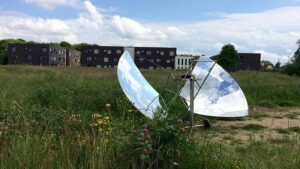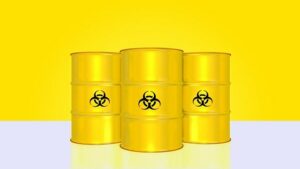Nuclear energy is obtained from chemical energy by the action of fusion or fission of radioactive elements.
The energy object by nuclear activities can be used to produce chemical energy through various processes. The heat energy released by the radioactive isotopes can be used to generate chemical fuels and other essentials. Let u discuss how to convert nuclear energy to chemical energy with examples.
How is nuclear energy converted to Chemical energy?
The energized nuclei release their extra energy by emitting the neutrons, photons, or electrons through the process of radioactivity to become a stable isotope.
The heat released can be used to supply the heat energy for chemical reactions to take place which requires a huge energy supply thus producing the essential oil and chemicals. This can be also used to generate electricity running a turbine which can be further converted into chemical energy.
Nuclear Reactor
Uranium and thorium are the most widely used isotopes in nuclear reactors.
The fission of the isotopes releases neutrons and gives out heat energy. This heat energy radiated is used to run the turbine. The generator further converts the mechanical energy to electrical energy.
Hydrogen Fuel
The hydrogen gas released in the fission reaction is collected and compressed to form a liquid. This is known as the hydrogen fuel and is listed as an eco-friendly fuel that produces an immense amount of energy as compared to the other fuel that is in use.
Desalination
The heat energy generated from the reactor is used for the desalination of the seawater process. The water molecules escape from the seawater and what remains is a variety of salt and minerals.
Steam
The heat released from the nuclear reactor is passed to the seawater to cool down the reactor. This heat energy is grasped by the water molecules in the water and the phase change occurs. The vapors thus formed are used to run the turbine to produce electrical energy.
Solar Cooker
Solar energy is a form of nuclear energy emitted from the Sun used to cook food which is a form of chemical energy.

Radioactivity
Radioactivity is responsible for the formation of different isotopes. These isotopes are used for various medical purposes and laboratory experiments.
Carbon Dating
The carbon is inhaled by almost all the living organisms and hence the carbon dating technologies are used to predict the life and era of the organic matter remnants.
Decomposition
Decomposition is a process of radioactive decay too. The matter degrades and the chemical composition varies as the time elapses.
Electric Vehicles
The electric vehicles are run on nuclear fuels and hydrogen fuels too. The chemical energy produced by the nuclear fuel is used for the combustion and to start the engine of a vehicle.

Atomic Blast
The atomic blast is due to the spontaneous radioactivity of the isotopes and thus releases a huge amount of energized particles in the air causing health hazards.
Nuclear Batteries
Nuclear batteries produce a large amount of energy and last for longer durations. Hence these can be used to save a lot of energy and reduce electronic waste.
Combustion of Fuels
The energy required for the combustion of fuels to generate energy is supplied by the energy generated in the nuclear reactor due to fission.
Food Treatment
Nuclear energy is also used to check any contaminants present in the food before it is bought into usage.
Photosynthesis
It is a process in which the plant uses the nuclear energy from the sun to produce their food by different chemical reactions and stores it in the form of chemical energy.

Fission
It is a bifurcation of the single nuclei into two releasing an amount of energy that is utilized for further chemical reactions to take place.
Fusion
It is a process of releasing the energy by emitting the photons or neutrons during the binding of two nuclei together forming an atom of molecular mass double the initial.
Nuclear Medicines
Nuclear medicines are used to detect cancerous cells, goiter, and various diseases and also in medical treatment for different illnesses.
Uranium Fuel
It produces tons of energy and is a clean source of energy that will save the emission of harmful chemicals into the atmosphere.

Chemical Reaction
Nuclear energy can supply the heat energy for the chemical reaction to occur.
Carbonaceous Fuel
This is a fuel acquired by the organic matter efficiency in carbon. This may be obtained by biofuel or from fossil fuels.
Frequently Asked Questions
How chemical energy is used to produce nuclear energy?
Nuclear energy is produced by releasing the energy acquired by the atom.
The energy is gained by the atom by some means of the chemical reaction or exposure to the tiny particles wandering in the system.
What is a form of nuclear energy?
Nuclear energy is in the form of both kinetic as well as potential energy.
The potential energy is stored energy in the nucleus when it is stable while the kinetic energy of the neutrons also transfers its energy to the atom on bombarding and makes it unstable.
Also Read:
- How to calculate energy in augmented reality
- How to calculate energy needed to heat
- How to design potential energy based emergency power systems for high rise buildings
- How to design nuclear energy efficient radiation therapy methods in cancer treatment
- Geothermal energy examples
- How to design elastic energy based earthquake dampers for buildings
- Can energy be negative
- How to find the energy of a damped oscillator
- How to estimate solar energy output based on panel specifications
- How to find kinetic energy with force and distance
Hi, I’m Akshita Mapari. I have done M.Sc. in Physics. I have worked on projects like Numerical modeling of winds and waves during cyclone, Physics of toys and mechanized thrill machines in amusement park based on Classical Mechanics. I have pursued a course on Arduino and have accomplished some mini projects on Arduino UNO. I always like to explore new zones in the field of science. I personally believe that learning is more enthusiastic when learnt with creativity. Apart from this, I like to read, travel, strumming on guitar, identifying rocks and strata, photography and playing chess.